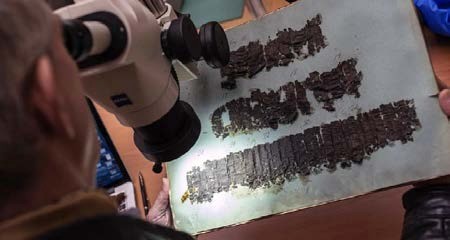X-Rays Reveal the Secrets of Ancient Scrolls

By Julianne Glauser
Nearly 2000 years ago, the ancient Roman cities of Pompeii and Herculaneum were destroyed and buried under volcanic ash by the eruption of Mount Vesuvius. Despite the devastating destruction, hundreds of papyrus scrolls stored in a Herculaneum library survived. The scrolls were unearthed in the 1750s, but due to their fragile condition, researchers had not been able to unwrap and read them…until now.
X-Rays Illuminating History
The cataclysmic eruption of Mt. Vesuvius in 79 A.D. buried the surrounding Italian towns and villages under tons of debris and ash up to 20 feet deep. The scrolls, stored inside the lone surviving villa library thought to belong to a Roman statesman, were charred by hot gases estimated to be in excess of 600° F. The tightly rolled ancient scrolls could reach up to 45 feet in length and were rolled right to left to allow reading left to right as they were unrolled.
With use of X-ray phase contrast tomography, a powerful 3D technology best known for its medical applications, a team from the Institute for Microelectronics and Microsystems of the National Council of Research, led by Vito Mocella, has successfully exposed the writing on the brittle papyrus scrolls without unwrapping them. The technology was able to distinguish the difference in refraction between the black ink on the scrolls and the charred papyrus, enabling scientists to identify words on the scrolls. Previous attempts with conventional X-ray technology were unable to differentiate between the ancient black ink made from smoke residues and the charred papyrus.
“This study, without compromising the physical integrity of the roll, has not merely discovered traces of the ink inside it, but has also helped identify with a certain likelihood the style of handwriting used in the text, along with its author,” noted Mocella. With the more powerful synchrotron X-ray machine, Mocella believes it will be possible to read entire scrolls.
Likewise, many scholars are excited about the prospect of unearthing previously hidden pieces of history. In the New York Times, Richard Janko, professor at the University of Michigan, optimistically added that “this technology, when perfected, does open the way to rediscovering a lot more ancient literature.”
Extension Questions
- What are additional applications for X-ray technology ?
- How did the ancient Romans make papyrus?